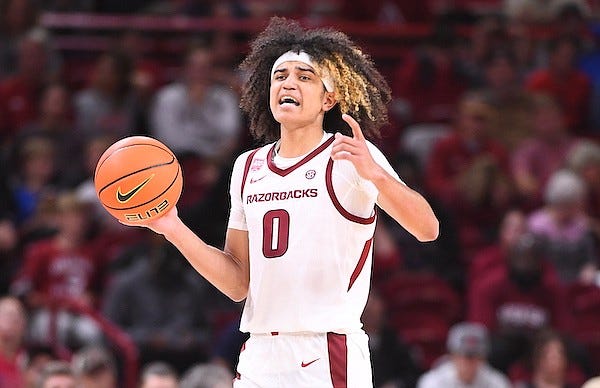The Case for the Thunder Trading Up for Anthony Black
Black would be an ideal fit for the OKC Thunder
Guest article written by Ben Glover
There is an old joke that an elephant for a dime is only a deal if you need an elephant and have a dime. The Thunder are in the unique position of having a pocket full of dimes, but do they need an elephant?
I got a phone call years ago from our local Ford dealership in Fairbanks. I had previously mentioned that we had 7 children at home. They called to ask if I would be interested in seeing a 10-passenger van that had been custom ordered and then not purchased.
It had sat on the lot for over a year, and they were offering it at a steep discount. We were lucky enough to have a dime when the elephant came up for sale.
Outside of Victor Wembanyama, Scoot Henderson, and Brandon Miller, there is perhaps no more natural fit than Anthony Black for the Thunder. He’s a huge guard (6’7” tall with a projected 7’0” wingspan) and possesses good athleticism. He is also an elite passer, a fantastic decision-maker, a terrific on-ball defender (his help defense is improving, but not a plus skill yet), and a willing driver who handles contact well.
His loose handle and below-average shot prevent him from being mentioned in the same breath as Wembanyama et al, but at his age and with focused development it is easy to imagine these skills improving dramatically
NBA Draft Room compares him to Josh Giddey but this equivalence is flawed. Giddey is bigger and a better rebounder. Black is a significantly better defender, especially on the perimeter, and is much more adept at handling contact. What the comparison does capture is the elite vision and passing skills both bring. Like Giddey, Black (.453/.301/.705) will also benefit from working with Chip Engelland.
Drafting Black is not without consequences. His minutes will have to come from somewhere. Tre Mann would almost certainly be traded or released. The rest would come from Lu Dort and/or Aaron Wiggins. Both young veterans are better basketball players than the 19-year-old Black is today.
It is short-term pain for probable (but not certain) long-term gain. The impact would not be huge but it would be irresponsible to not address it.
Fellow Thunder fan Derek Parker has a terrific video about Black here. I encourage you to check it out.
Now to the price of Anthony Black. Oklahoma City will pick at #12 and Black will likely not fall below #7. Using the NBASense Draft Pick Trade Value chart , the 12th pick is worth 1500 points. The 7th pick is worth 2000. In strong drafts, there is usually a premium on trading up which could mean it might take 750 additional points to trade up, not 500.
This phenomenon was seen last year in what was a good draft. It took 3 protected first round picks for the Thunder to trade for the Knicks pick and land Dieng at #11. It is an overpay according to the trade value chart above. The Thunder have extra picks in each of the four drafts from 2024-2027.
The draft value chart shows that the fair value for the 7th pick is the 12th and the 24th pick. It’s easy to imagine a team seeking an even greater premium, but this offer is the starting point for negotiations.
The Thunder do not have an extra first round pick in 2023 and their second round pick does not come close value-wise. It is never easy to give a valuation for future picks but if one reasonably assumes Houston will have a pick within the top-8, giving up that pick is too much.
On the other hand, any quality GM will argue that the Clippers have top 3 NBA talent and their pick is not valuable enough. The Utah pick has the best chance to be roughly about right. If the Thunder offered the Utah pick to move up from #12 to #7, a GM would probably ask for #38 and Presti might agree considering the Thunder could have a potential roster crunch.
So, is Anthony Black worth #12, #38, and Utah’s top 10 protected pick in 2024? Yes. The team is close and adding an obvious fit only expands the long-term possibilities. There will not be enough room for four draft picks next year and there may not have been enough room for #38 this year. On paper, it is an overpay, but it’s going to cost at least a dime if you want to buy an elephant.





Beautiful breakdown. The one thing I missed with Kevin Pelton's chart (even more so as he used an example where a team trades up to the top of the draft): the total value might seem simple math but it's not. If you add 'fair' value like the number 14 pick to trade up from 3 to 1, this leaves out that the team with the number 1 pick has ONE better player on the floor. The second pick that the other team gains does not add full value - because that player needs to play in order to make that theoretical value a reality. Once he does play, you gotta sub a different player (and deduct his value). So adding another guy to the roster adds value but lineups are a different matter. I would ask for quite a bit more than the value assigned in the chart. Nonetheless, the chart helps to estimate trade value in a variety of situations. Obviously there's exceptions (Luka, Wemby, LeBron, AD...) where the value is much, much higher.
For OKC, I'm over the moon with the trade for Cason Wallace. Brilliant pick and trade